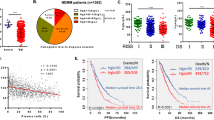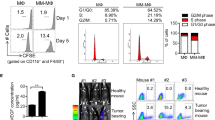Abstract
Multiple myeloma is a mostly incurable malignancy characterized by the expansion of a malignant plasma cell (PC) clone in the human bone marrow (BM). Myeloma cells closely interact with the BM stroma, which secretes soluble factors that foster myeloma progression and therapy resistance. Growth arrest-specific gene 6 (Gas6) is produced by BM-derived stroma cells and can promote malignancy. However, the role of Gas6 and its receptors Axl, Tyro3 and Mer (TAM receptors) in myeloma is unknown. We therefore investigated their expression in myeloma cell lines and in the BM of myeloma patients and healthy donors. Gas6 showed increased expression in sorted BMPCs of myeloma patients compared with healthy controls. The fraction of Mer+ BMPCs was increased in myeloma patients in comparison with healthy controls whereas Axl and Tyro3 were not expressed by BMPCs in the majority of patients. Downregulation of Gas6 and Mer inhibited the proliferation of different myeloma cell lines, whereas knocking down Axl or Tyro3 had no effect. Inhibition of the Gas6 receptor Mer or therapeutic targeting of Gas6 by warfarin reduced myeloma burden and improved survival in a systemic model of myeloma. Thus, the Gas6-Mer axis represents a novel candidate for therapeutic intervention in this incurable malignancy.
This is a preview of subscription content, access via your institution
Access options
Subscribe to this journal
Receive 12 print issues and online access
$259.00 per year
only $21.58 per issue
Buy this article
- Purchase on Springer Link
- Instant access to full article PDF
Prices may be subject to local taxes which are calculated during checkout







Similar content being viewed by others
Change history
03 March 2020
A Correction to this paper has been published: https://doi.org/10.1038/s41375-020-0781-5
References
Kuehl WM, Bergsagel PL . Molecular pathogenesis of multiple myeloma and its premalignant precursor. J Clin Invest 2012; 122: 3456–3463.
Palumbo A, Anderson K . Multiple myeloma. N Engl J Med 2011; 364: 1046–1060.
Schmidt T, Ben-Batalla I, Schultze A, Loges S . Macrophage-tumor crosstalk: role of TAMR tyrosine kinase receptors and of their ligands. Cell Mol Life Sci 2012; 69: 1391–1414.
Lemke G, Rothlin CV . Immunobiology of the TAM receptors. Nat Rev Immunol 2008; 8: 327–336.
Angelillo-Scherrer A, Burnier L, Flores N, Savi P, DeMol M, Schaeffer P et al. Role of Gas6 receptors in platelet signaling during thrombus stabilization and implications for antithrombotic therapy. J Clin Invest 2005; 115: 237–246.
Angelillo-Scherrer A, de Frutos P, Aparicio C, Melis E, Savi P, Lupu F et al. Deficiency or inhibition of Gas6 causes platelet dysfunction and protects mice against thrombosis. Nat Med 2001; 7: 215–221.
Angelillo-Scherrer A, Burnier L, Lambrechts D, Fish RJ, Tjwa M, Plaisance S et al. Role of Gas6 in erythropoiesis and anemia in mice. J Clin Invest 2008; 118: 583–596.
Fernandez-Fernandez L, Bellido-Martin L, Garcia de Frutos P . Growth arrest-specific gene 6 (GAS6). An outline of its role in haemostasis and inflammation. Thromb Haemost 2008; 100: 604–610.
Hafizi S, Dahlback B . Gas6 and protein S. Vitamin K-dependent ligands for the Axl receptor tyrosine kinase subfamily. FEBS J 2006; 273: 5231–5244.
Lai C, Lemke G . An extended family of protein-tyrosine kinase genes differentially expressed in the vertebrate nervous system. Neuron 1991; 6: 691–704.
McCloskey P, Pierce J, Koski RA, Varnum B, Liu ET . Activation of the Axl receptor tyrosine kinase induces mitogenesis and transformation in 32D cells. Cell Growth Differ 1994; 5: 1105–1117.
Lierman E, Van Miegroet H, Beullens E, Cools J . Identification of protein tyrosine kinases with oncogenic potential using a retroviral insertion mutagenesis screen. Haematologica 2009; 94: 1440–1444.
Hutterer M, Knyazev P, Abate A, Reschke M, Maier H, Stefanova N et al. Axl and growth arrest-specific gene 6 are frequently overexpressed in human gliomas and predict poor prognosis in patients with glioblastoma multiforme. Clin Cancer Res 2008; 14: 130–138.
Ito T, Ito M, Naito S, Ohtsuru A, Nagayama Y, Kanematsu T et al. Expression of the Axl receptor tyrosine kinase in human thyroid carcinoma. Thyroid 1999; 9: 563–567.
Sawabu T, Seno H, Kawashima T, Fukuda A, Uenoyama Y, Kawada M et al. Growth arrest-specific gene 6 and Axl signaling enhances gastric cancer cell survival via Akt pathway. Mol Carcinog 2007; 46: 155–164.
Sun W, Fujimoto J, Tamaya T . Coexpression of Gas6/Axl in human ovarian cancers. Oncology 2004; 66: 450–457.
Sun WS, Fujimoto J, Tamaya T . Coexpression of growth arrest-specific gene 6 and receptor tyrosine kinases Axl and Sky in human uterine endometrial cancers. Ann Oncol 2003; 14: 898–906.
Sainaghi PP, Castello L, Bergamasco L, Galletti M, Bellosta P, Avanzi GC . Gas6 induces proliferation in prostate carcinoma cell lines expressing the Axl receptor. J Cell Physiol 2005; 204: 36–44.
van Ginkel PR, Gee RL, Shearer RL, Subramanian L, Walker TM, Albert DM et al. Expression of the receptor tyrosine kinase Axl promotes ocular melanoma cell survival. Cancer Res 2004; 64: 128–134.
Loges S, Schmidt T, Tjwa M, van Geyte K, Lievens D, Lutgens E et al. Malignant cells fuel tumor growth by educating infiltrating leukocytes to produce the mitogen Gas6. Blood 2010; 115: 2264–2273.
Ben-Batalla I, Schultze A, Wroblewski M, Erdmann R, Heuser M, Waizenegger JS et al. Axl, a prognostic and therapeutic target in acute myeloid leukemia mediates paracrine crosstalk of leukemia cells with bone marrow stroma. Blood 2013; 122: 2443–2452.
Keating AK, Salzberg DB, Sather S, Liang X, Nickoloff S, Anwar A et al. Lymphoblastic leukemia/lymphoma in mice overexpressing the Mer (MerTK) receptor tyrosine kinase. Oncogene 2006; 25: 6092–6100.
Cummings CT, Deryckere D, Earp HS, Graham DK . Molecular pathways: MERTK signaling in cancer. Clin Cancer Res 2013; 19: 5275–5280.
Lee-Sherick AB, Eisenman KM, Sather S, McGranahan A, Armistead PM, McGary CS et al. Aberrant Mer receptor tyrosine kinase expression contributes to leukemogenesis in acute myeloid leukemia. Oncogene 2013; 32: 5359–5368.
Graham DK, Salzberg DB, Kurtzberg J, Sather S, Matsushima GK, Keating AK et al. Ectopic expression of the proto-oncogene Mer in pediatric T-cell acute lymphoblastic leukemia. Clin Cancer Res 2006; 12: 2662–2669.
Ling L, Kung HJ . Mitogenic signals and transforming potential of Nyk, a newly identified neural cell adhesion molecule-related receptor tyrosine kinase. Mol Cell Biol 1995; 15: 6582–6592.
Stitt TN, Conn G, Gore M, Lai C, Bruno J, Radziejewski C et al. The anticoagulation factor protein S and its relative, Gas6, are ligands for the Tyro 3/Axl family of receptor tyrosine kinases. Cell 1995; 80: 661–670.
Ben-Batalla I, Seoane S, Garcia-Caballero T, Gallego R, Macia M, Gonzalez LO et al. Deregulation of the Pit-1 transcription factor in human breast cancer cells promotes tumor growth and metastasis. J Clin Invest 2010; 120: 4289–4302.
Fryer RA, Graham TJ, Smith EM, Walker-Samuel S, Morgan GJ, Robinson SP et al. Characterization of a novel mouse model of multiple myeloma and its use in preclinical therapeutic assessment. PLoS One 2013; 8: e57641.
Weber K, Bartsch U, Stocking C, Fehse B . A multicolor panel of novel lentiviral 'gene ontology' (LeGO) vectors for functional gene analysis. Mol Ther 2008; 16: 698–706.
Weber K, Mock U, Petrowitz B, Bartsch U, Fehse B . Lentiviral gene ontology (LeGO) vectors equipped with novel drug-selectable fluorescent proteins: new building blocks for cell marking and multi-gene analysis. Gene Ther 2010; 17: 511–520.
Hose D, Reme T, Meissner T, Moreaux J, Seckinger A, Lewis J et al. Inhibition of aurora kinases for tailored risk-adapted treatment of multiple myeloma. Blood 2009; 113: 4331–4340.
Seckinger A, Meissner T, Moreaux J, Depeweg D, Hillengass J, Hose K et al. Clinical and prognostic role of annexin A2 in multiple myeloma. Blood 2012; 120: 1087–1094.
Wu Z IR, Gentleman R, Martinez-Murillo F, Spencer F . A model-based background adjustment for oligonucleotide expression arrays. J Am Stat Assoc 2004; 99: 909–917.
Johnson WE, Li C, Rabinovic A . Adjusting batch effects in microarray expression data using empirical Bayes methods. Biostatistics 2007; 8: 118–127.
Warren P TD, Martini PGV, Jackson J, Bienkowska J . PANP–a new method of gene detection on oligonucleotide expression arrays. BIBE 2007 Proceedings of the 7th IEEE International Conference on Bioinformatics and Bioengineering 2007; 2007, pp 108–115.
Boysen J, Sinha S, Price-Troska T, Warner SL, Bearss DJ, Viswanatha D et al. The tumor suppressor axis p53/miR-34a regulates Axl expression in B-cell chronic lymphocytic leukemia: implications for therapy in p53-defective CLL patients. Leukemia 2014; 28: 451–455.
Chauhan D, Neri P, Velankar M, Podar K, Hideshima T, Fulciniti M et al. Targeting mitochondrial factor Smac/DIABLO as therapy for multiple myeloma (MM). Blood 2007; 109: 1220–1227.
Yanagita M, Arai H, Ishii K, Nakano T, Ohashi K, Mizuno K et al. Gas6 regulates mesangial cell proliferation through Axl in experimental glomerulonephritis. Am J Pathol 2001; 158: 1423–1432.
Zhan F, Huang Y, Colla S, Stewart JP, Hanamura I, Gupta S et al. The molecular classification of multiple myeloma. Blood 2006; 108: 2020–2028.
Lentzsch S, Chatterjee M, Gries M, Bommert K, Gollasch H, Dorken B et al. PI3-K/AKT/FKHR and MAPK signaling cascades are redundantly stimulated by a variety of cytokines and contribute independently to proliferation and survival of multiple myeloma cells. Leukemia 2004; 18: 1883–1890.
Liu J, Zhang W, Stashko MA, Deryckere D, Cummings CT, Hunter D et al. UNC1062, a new and potent Mer inhibitor. Eur J Med Chem. 2013; 65: 83–93.
Christoph S, Deryckere D, Schlegel J, Frazer JK, Batchelor LA, Trakhimets AY et al. UNC569, a novel small-molecule Mer inhibitor with efficacy against acute lymphoblastic leukemia i n vitro and in vivo. Mol Cancer Ther 2013; 12: 2367–2377.
Acknowledgements
SL is supported by the Max-Eder group leader program from Deutsche Krebshilfe, the Deutsche Forschungsgemeinschaft (DFG), the Roggenbuck Stiftung, the Hamburger Krebsgesellschaft, the Medical Faculty of the University of Hamburg (FFM program) and the Hamburger Exzellenzinitiative (LEXI program). HT was supported by an EMBO Long Term Postdoctoral Fellowship and by a Post-Doctoral fellowship from the Alexander von Humboldt foundation. EH is supported by the DFG Heisenberg-Program and receives funding from DFG. MJ is supported by a Hubertus-Wald fellowship. KP is supported by the ERC Advanced Investigator Grant no. 269081 “DISSECT”. We thank Dr. Carol Stocking (Heinrich Pette Institute, Hamburg, Germany) for supplying OP9 cells. We thank Nils Jäger on behalf of the Animal Facility (VTH) at University Medical Center Hamburg-Eppendorf for taking care of the mice housing and the FACS core facility of the UKE for the sorting.
Author Contributions
SL initiated, conceived of, designed and supervised research, wrote the manuscript and analyzed data. JSW and IBB designed experiments, wrote the manuscript, performed experiments and analyzed data. NW, TM, MW, KR, HT, SS, VG, MCC and MJ performed experiments and data analysis. MB, DA, DS, WF, EH, NK, BF, DH, BK, MSR, KP and CB contributed vital new reagents and commented on the research direction and edited the manuscript. All authors discussed and commented on the manuscript.
Author information
Authors and Affiliations
Corresponding author
Ethics declarations
Competing interests
The authors declare no conflict of interest.
Additional information
Supplementary Information accompanies this paper on the Leukemia website
Supplementary information
Rights and permissions
About this article
Cite this article
Waizenegger, J., Ben-Batalla, I., Weinhold, N. et al. Role of Growth arrest-specific gene 6-Mer axis in multiple myeloma. Leukemia 29, 696–704 (2015). https://doi.org/10.1038/leu.2014.236
Received:
Revised:
Accepted:
Published:
Issue Date:
DOI: https://doi.org/10.1038/leu.2014.236
This article is cited by
-
TAM family kinases as therapeutic targets at the interface of cancer and immunity
Nature Reviews Clinical Oncology (2023)
-
Single-cell analysis of multiple myelomas refines the molecular features of bortezomib treatment responsiveness
Experimental & Molecular Medicine (2022)
-
Regulation of bone homeostasis by MERTK and TYRO3
Nature Communications (2022)
-
Exosomal circRNA as a novel potential therapeutic target for multiple myeloma-related myocardial damage
Cancer Cell International (2021)
-
Bone marrow niches in haematological malignancies
Nature Reviews Cancer (2020)



